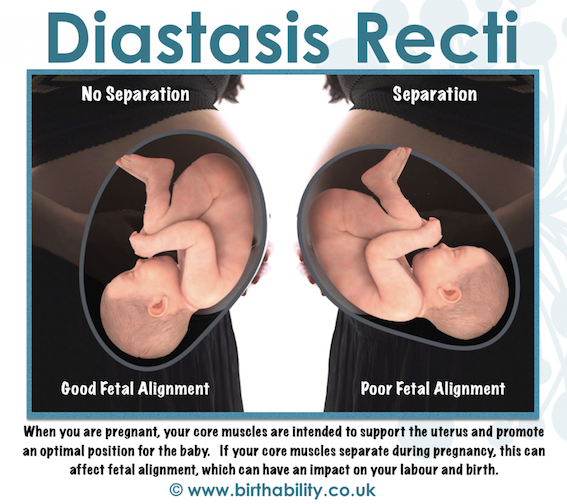
Diastasis Recti – What does it mean for Pregnant and Postnatal women
Everywhere I look on Facebook at the moment, there are videos and posts talking about Diastasis Recti. Unless you have heard of it before, it may be very confusing, and not something that many pregnant or postnatal women realise is about them.
Simply put, Diastasis Recti or Diastasis Recti Abdominis means separation of the abdominal muscles (six pack muscles).
To be clear – It is perfectly normal for this to happen.
It can simply be caused due to the surge of hormones that soften and loosen the body in preparation for birth in order to make room for baby.
LET ME EXPLAIN:-
When a woman’s body begins to grow a baby they go through so many incredible changes, most of which you will already be aware of like increased blood volume – flowing to your kidneys, filling your bladder and making you pee more often and changes to the breasts etc:-
As the pregnancy continues into the second trimester, the uterus comes out of the pelvis and the abdomen begins to grow upwards and outwards as the baby develops.
During this time, all of the pregnant woman’s major organs begin to miraculously move out of the way to make room for the baby.
Sometimes as the baby grows, the tummy muscles can separate.
This can have a direct impact on labour and birth for this and any future pregnancies.
The reason for this is because the Linea Alba (Connective tissue) between the muscles is thin and weakened, and there is little or no support for the baby (see picture above).
The baby can potentially drop forward, which may prevent them engaging into the pelvis. This will then create more outward pressure on the connective tissue – possibly making your diastasis worse and preventing the baby from aligning with the cervix.
If this is not corrected or helped to go back as much as possible, it may have also have a huge impact on a future pregnancy. This is because a weakened core can:- lead to pelvic girdle pain and affect fetal alignment.
The most common physical side affects of Diastasis Recti that we hear about are:-
In Pregnancy:-
• Pelvic Pain
• Hip Pain
• Sciatica
• Back pain
• Pubic pain
• Poor alignment of the baby
• Potential long and difficult birth
In the Postnatal Period:-
• Pelvic floor weakness and incontinence
• Lower back pain
• Pain in the pelvic area
• Hernia
• Intestinal and digestive issues
• Poor posture and ability to breathe effectively
• “A mummy tummy” which isn’t going away no matter what you try (diet and exercise.)
THE GOOD NEWS IS:
That Diastasis Recti is something that you can fix and sort out both in Pregnancy or in the Postnatal Period.
There are several ways to do this:-
- Get checked to assess your abdominal separation – If you suspect you have separation of the abdominal muscles (diastasis recti), you can be checked by a local expert. We recommend Jayne @ The Women’s Wellness Coach.
- You can learn how to do a more simple method at home looking at videos online. We recommend The Tummy Team. Anything over 3-4 fingers wide is considered to be something that you may want to seek help for, especially if you are experiencing any of the symptoms above.
- Posture is important – Antenatal Yoga can therefore be an invaluable part of your birth preparation.
- Pelvic Floor – Your pelvic floor muscle is like any other muscle in the body. The more you strengthen it the more improvement you will see.
Most separations are completely correctable, you just want to ensure that you don’t participate in any form of exercise that may make the separation worse, until your separation has been supported and improved. Avoid any activities that put more pressure on the connective tissue. This includes running, jumping, planks, crunches, and some high impact classes.
Women who are more prone to Diastasis Recti include:-
1. Women who have had pregnancies close together.
2. Women who have had a twin/multiple pregnancy.
3. Women who have had a C Section with a previous birth (the muscles are separated to gain access to the abdominal cavity).
4. Women who have had their belly button pierced (this can damage the Linea Alba).
5. Women who suffer with consistent constipation/coughing/sneezing.
6. Women who have done excessive sit-ups or push-ups in the past resulting in chronic straining of the abdominals.
7. Women with a high BMI.
8. Women who are hyper mobile.
Please note:- Diastastis Recti can also happen to Men, Children and Non-pregnant women, when they do incorrect exercise and put strain on their abdominal muscles.




No Comments